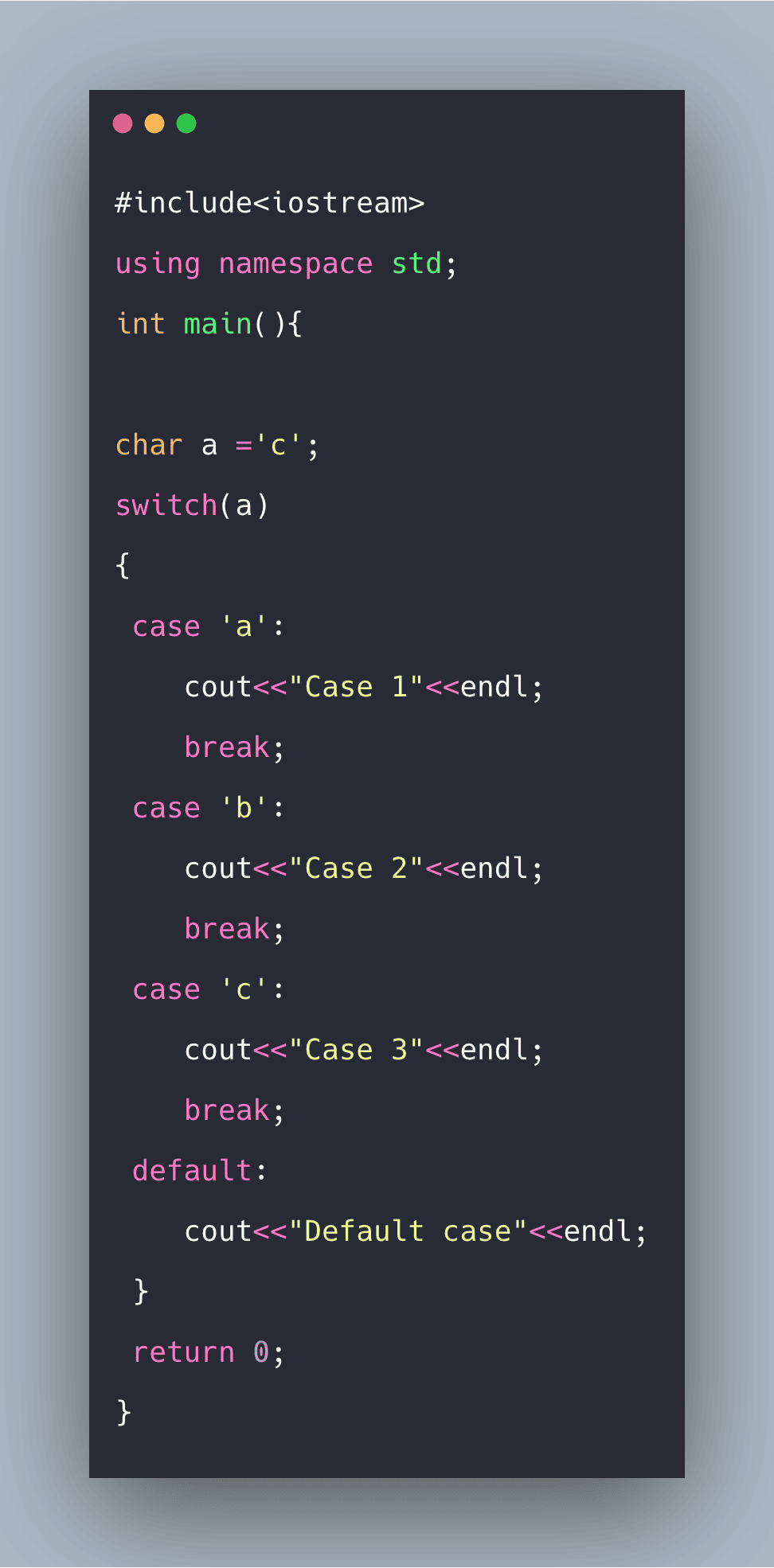Dev C++ Switch Statement Examples
Allows selection among multiple sections of code, depending on the value of an integral expression. Dlym vst free download.
An if statement can be followed by an optional else if.else statement, which is very usefull to test various conditions using single if.else if statement. When using if, else if, else statements there are few points to keep in mind. Dec 21, 2008 Using Range in the Case Values of Switch Statement C Programming Video Tutorial - Duration: 12:07. LearningLad 16,202 views. Shapes in c using nested loops and pattern.
- Jun 08, 2014 Searches related to c tutorial switch case how to use switch case in c switch case c beispiel c switch case string c switch case range c switch case enum switch case c.
- In this lesson, we will discuss the C switch statement for control flow and exactly how you could use a switch statement. We will also cover some differences between the switch statement and the.
Syntax
switch ( [initialization;] expression){caseconstant-expression:statement
[default :statement]}
Remarks
The expression must have an integral type, or be a class type that has an unambiguous conversion to integral type. Integral promotion takes place as described in Standard conversions.
The switch statement body consists of a series of case labels and an optional default label. Collectively, the statements that follow the labels are called labeled statements. The labeled statements aren't syntactic requirements, but the switch statement is meaningless without them. No two constant expressions in case statements may evaluate to the same value. The default label may appear only once. The default statement is often placed at the end, but it can appear anywhere in the body of the switch statement. A case or default label can only appear inside a switch statement.
The constant-expression in each case label is converted to the type of expression. Then, it's compared with expression for equality. Control passes to the statement whose caseconstant-expression matches the value of expression. The resulting behavior is shown in the following table.
Switch statement behavior
| Condition | Action |
|---|---|
| Converted value matches that of the promoted controlling expression. | Control is transferred to the statement following that label. |
| None of the constants match the constants in the case labels; a default label is present. | Control is transferred to the default label. |
| None of the constants match the constants in the case labels; no default label is present. | Control is transferred to the statement after the switch statement. |
If a matching expression is found, execution can continue through later case or default labels. The break statement is used to stop execution and transfer control to the statement after the switch statement. Without a break statement, every statement from the matched case label to the end of the switch, including the default, is executed. For example:
In the above example, uppercase_A is incremented if c is an uppercase 'A'. The break statement after uppercase_A++ terminates execution of the switch statement body and control passes to the while loop. Without the break statement, execution would 'fall through' to the next labeled statement, so that lowercase_a and other would also be incremented. A similar purpose is served by the break statement for case 'a'. If c is a lowercase 'a', lowercase_a is incremented and the break statement terminates the switch statement body. If c isn't an 'a' or 'A', the default statement is executed.
Visual Studio 2017 and later: (available with /std:c++17) The [[fallthrough]] attribute is specified in the C++17 standard. You can use it in a switch statement. It's a hint to the compiler, or anyone who reads the code, that fall-through behavior is intentional. The Microsoft C++ compiler currently doesn't warn on fallthrough behavior, so this attribute has no effect on compiler behavior. In the example, the attribute gets applied to an empty statement within the unterminated labeled statement. In other words, the semicolon is necessary.
Visual Studio 2017 version 15.3 and later (available with /std:c++17). A switch statement may have an initialization clause. It introduces and initializes a variable whose scope is limited to the block of the switch statement:
An inner block of a switch statement can contain definitions with initializations as long as they're reachable, that is, not bypassed by all possible execution paths. Names introduced using these declarations have local scope. For example: /how-to-auto-tune-rap.html.
A switch statement can be nested. When nested, the case or default labels associate with the closest switch statement that encloses them.
Microsoft-specific behavior
Microsoft C doesn't limit the number of case values in a switch statement. The number is limited only by the available memory. ANSI C requires at least 257 case labels be allowed in a switch statement.
The default for Microsoft C is that the Microsoft extensions are enabled. Use the /Za compiler option to disable these extensions.
See also
Selection Statements
Keywords
The switch statement in C++ is a control statement that is useful in a limited number of cases. The switch statement resembles a compound if statement by including a number of different possibilities rather than a single test:
The value of expression must be an integer (int, long, or char). The case values must be constants.
As of the ‘14 standard, they can also be a constant expression.
When the switch statement is encountered, the expression is evaluated and compared to the various case constants. Control branches to the case that matches. If none of the cases match, control passes to the default clause.
Consider the following example code snippet:
Dev C++ Example Graphics Programs

Switch Statement C++ With Numbers
Once again, the switch statement has an equivalent; in this case, multiple if statements. However, when there are more than two or three cases, the switch structure is easier to understand.
C Switch Case Example
The break statements are necessary to exit the switch command. Without the break statements, control falls through from one case to the next. (Look out below!)



